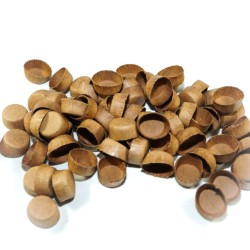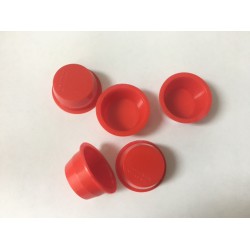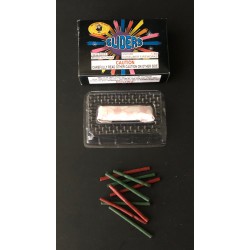White flare star
Source: "Vuurwerk door de eeuwen heen"[11]
Comments: Dangerous mixture since it contains both sulfur and a chlorate.
Preparation: Wet with solution of shellac in ethanol. ±20g Shellac per liter of ethanol.
Potassium nitrate.................................165
Sulfur............................................31
Barium nitrate....................................455
Barium chlorate...................................31
Magnesium powder..................................18
Aluminum medium course............................5
Aluminum fine.....................................25
Gold flitter star
Source:
Comments: The particle sizes of aluminum powders will markedly affect the result. If Al bronze is available, you can use all 16 parts of it instead of the two different Al powders.
Preparation: Add water and proceed as usual.
Potassium nitrate, fine...........................16
Sulfur............................................3
Charcoal, powdered................................2
Sodium oxalate or Ultramarine.....................4 or 2
Fine, grey aluminum powder (preferably pyro Aluminum).....11
Flake Aluminum or medium Al powder (Al bronze works well).....5
Dextrin...........................................4
Zinc spreader star #1
Source: "The Pyroguide" (a document found on internet)
Comments: The stars spread pieces of burning zinc and charcoal. These stars are much heavier than usual, and require larger lifter charges if they're to be fired from a tube.
Preparation: Bind with water.
Zinc dust.........................................72
Potassium chlorate................................15
Potassium dichromate..............................12
Granular charcoal.................................12
Dextrin...........................................2
Zinc spreader star #2
Source: "The Pyroguide" (a document found on internet)
Comments:
Preparation: Bind with dextrin in water.
Potassium nitrate.................................14
Zinc dust.........................................40
Charcoal..........................................7
Sulfur............................................4
Zinc spreader star #3
Source: "The Pyroguide" (a document found on internet)
Comments: Bind with dextrin in water.
Preparation:
Potassium chlorate................................5
Potassium dichromate..............................4
Charcoal, medium..................................4
Zinc dust.........................................24
Willow tree star
Source: "The Pyroguide" (a document found on internet)
Comments: Dangerous mixture since it contains both sulfur and a chlorate.
Preparation: Bind with dextrin in water.
Potassium chlorate................................10
Potassium nitrate.................................5
Sulfur............................................1
Lampblack.........................................18
Soft willow lampblack star
Source: "Mesquite charcoal" from Tom Perigrin's homepage.
Comments:
Preparation: Use a meal powder prime. 1 part shellac can be used instead of 5 parts, burning time will be reduced by 2 sec. Standard willow method: mix the components, wet with alcohol/water screen pulverone style, dry, mill for 3 hours then make cut stars. Adding extra charcoal might slow the burn, giving a better tail.
Charcoal..........................................25
Dextrin...........................................5
Potassium nitrate.................................10
Potassium perchlorate.............................30
Lampblack.........................................30
Shellac...........................................5
Lampblack willow star
Source: PML, post by Bill Ofca <ofca@csbh.mhv.net
Comments:
Preparation: Dampen with 50/50 water/alcohol as it is rolled over a (chlorate) core star or stars containing NO sulfur or sulfur compounds. It helps to slightly dampen the lampblack with pure alcohol before it is mixed with the other dry ingredients. Once thoroughly mixed, it should still flow as a powder, or too much alcohol was used. If that happens, allow it to evaporate for awhile until it can be sprinkled on the rolling stars.
Lampblack.........................................12
Potassium chlorate................................8
Potassium nitrate.................................1
Dextrin...........................................1
Silver shower star #1
Source:
Comments:
Preparation: Add water and proceed as usual. The particle size and surface area of the reactants has a profound effect on the results.
Potassium nitrate.................................35
Fine charcoal.....................................8
Boric acid........................................2
Sulfur............................................7
Potassium perchlorate.............................60
Fine pyro Aluminum (atomised Aluminum, 0.1 mm)....20
Fine flake aluminum (Al bronze)...................25
Coarse flake Aluminum.............................15
Dextrin...........................................10
Silver shower star #2
Source: PML, post by Charley Wilson <cwilson@celsvr.stortek.com.
Comments: The particle size of the aluminum is not very critical.
Preparation: Dissolve shellac in boiling ethanol, mix in the other ingredients and proceed as usual. Shellac stars take a long time to dry; try drying in the sun. Prime with a perchlorate based strobe prime.
Ammonium perchlorate..............................65
Fine aluminum powder or flake aluminum (not too coarse).....22
Shellac...........................................18
Silver shower star #3
Source:
Comments:
Preparation: Add water and proceed as usual.
Flitter Aluminum (or any grade except the finest pyro grades).....15
Potassium nitrate.................................55
Boric acid........................................2
Fine charcoal.....................................10
Dextrin...........................................5
Electric star #1
Source: "The Pyroguide" (a document found on internet)
Comments:
Preparation: Bind with dextrin in water.
Potassium nitrate.................................15
Aluminum, fine....................................2
Aluminum, medium..................................1
Black powder......................................2
Antimony sulfide..................................3
Sulfur............................................4
Electric star #2
Source: "The Pyroguide" (a document found on internet)
Comments:
Preparation: Bind with red gum in water.
Potassium chlorate................................60
Barium nitrate....................................5
Aluminum, fine....................................9
Aluminum, medium..................................4
Aluminum, coarse..................................3
Charcoal..........................................2
Dextrin...........................................5
Electric star #3
Source: "The Pyroguide" (a document found on internet)
Comments:
Preparation: Bind with shellac in alcohol.
Potassium perchlorate.............................6
Barium nitrate....................................1
Aluminum..........................................20
Dextrin...........................................1
Electric star #4
Source: "The Pyroguide" (a document found on internet)
Comments:
Preparation: Bind with shellac in alcohol.
Potassium perchlorate.............................4
Aluminum, medium..................................2
Dextrin...........................................1
Firefly #1
Source: rec.pyrotechnics archive. Posted by Eric Eisack.
Comments:
Preparation: Aluminum is large flake. It was sieved through a windowscreen. This gives about 30 mesh powder.
Potassium nitrate.................................50
Charcoal,air float................................29
Charcoal, 80 mesh.................................10.5
Sulfur............................................6
Aluminum (large flake)............................4.5
Dextrin or CMC....................................+5 or +1
Firefly #2
Source: rec.pyrotechnics archive. Posted by Dan Bucciano.
Comments: Can also be used as rocket propellant: Mix the chemicals, dampen, and granulate through a 20 mesh screen and dry. Use +3% by weight as a tail effect. Once you have passed the top core of the rocket by 1/2 inch, you may ram 100% firefly formula the rest of the way. You will end up with a beautiful long trailing tail of firefly.
Preparation:
Potassium Nitrate.................................47
Air Float Charcoal................................33
Antimony tri-sulfide..............................5.8
Aluminum (400 mesh,12 micron, spherical)..........4.2
Sulfur............................................4.7
Dextrin...........................................5.2
Firefly #3
Source: PML Digest 391, post by L.Niksch <LNiksch@aol.com. This formula is provided with the "firefly aluminum" from Skylighter.
Comments:
Preparation: Ball mill potassium nitrate, Air Float charcoal, sulfur and Dextrin together for 1 hour. Then add the 36 mesh Charcoal and firefly aluminum and mix with a spoon. Add water to make a dough mix and cut with a knife into 3/8" cut stars. Separate stars and dry for 3-4 days. The effect is a long tiger tail going up and firefly sparkles coming down. Larger stars take longer to dry, and a damp star produces very little firefly effect.
Potassium nitrate.................................49
Charcoal, air float...............................29
Charcoal, 36 Mesh.................................11
Sulfur............................................9
Dextrin...........................................10
Aluminum, firefly.................................5
Glitter star
Source: rec.pyrotechnics archive, post by Tommy Hakomaki <tommy.hakomaki@mailbox.swipnet.se
Comments:
Preparation: Wet with ethanol/water (70/30)
Potassium nitrate.................................55
Aluminum 200-400 mesh.............................5
Dextrin...........................................4
Antimony(III)sulfide..............................16
Sulfur............................................10
Lampblack.........................................10
Red Pill Box star
Source: rec.pyrotechnics archive. Composition from Lancaster[2]
Comments:
Preparation:
Potassium chlorate................................64
Strontium carbonate...............................19
Red gum...........................................13
Dextrin...........................................4
Sparkler star
Source: rec.pyrotechnics archive.
Comments: Use course aluminum, fine aluminum will only result in a flash.
Preparation:
Potassium perchlorate.............................60
Aluminum, course..................................30
Dextrin...........................................10
White flitter star
Source: Tom's Perigrin's homepage. Composition from Weingart[5].
Comments:
Preparation:
Potassium nitrate.................................17
Sulfur............................................3
Charcoal..........................................3
Aluminum, course..................................4
Aluminum flake, fine..............................10
Dextrin...........................................1
White comet #1
Source: rec.pyrotechnics
Comments:
Preparation:
Potassium nitrate.................................96
Fine charcoal.....................................44
Sulfur............................................15
Dextrin...........................................10
White comet #2
Source: rec.pyrotechnics
Comments:
Preparation:
Potassium nitrate.................................40
Fine charcoal.....................................24
Sulfur............................................8
Dextrin...........................................9
'Dragon eggs' star (Crackling star)
Source: rec.pyrotechnics. Composition from "The best of AFN III"[12], page 121
Comments: Sometimes, Bi2O3 is used instead of Pb3O4. The composition is extremely sensitive, both to friction and impact. It is also quite poisonous and explosive. Gloves and an air mask must be worn at all times when handling this mixture since the mixture contains the very toxic Pb3O4.
Preparation: Add lacquer untill the thickness is like wood putty. Pass the mix through a screen and dry it to make 1mm squares. These will explode with a sharp crack shortly after lighting and can be used as star cores.
Pb3O4.............................................81.8
Magnalium (50/50, 100-200 Mesh)...................9.1
Copper(II)oxide...................................9.1
Nitrocellulose lacquer binder.....................10% by volume
Blue star with charcoal tail
Source: rec.pyrotechnics, posted by sweden <sweden@synchron.ct.se. Source of this composition is Bruce Snowden
Comments:
Preparation: Add isopropyl alcohol for binding. Cut, round and pumped stars can be made with this composition, but a typical KClO4/Red gum/Charcoal/dextrin prime will be necessary. A final layer of sodium nitrate/sulfur/Charcoal (85/5/10), moistened with NC/acetone lacker (w. about 3% NC) can be added. This adds yellowish sparks. Mealpowder can be used instead if the yellow sparks are not desired.
Ammonium perchlorate..............................70
Basic copper carbonate............................10
Red Gum...........................................10
Charcoal..........................................10
Dextrin...........................................+5
Electric purple star
Source: Quoted in an AFN Yearbook from David Bleser on "Protecting Electric Puple Decomposition"
Comments: When very fine powdered ammonium perchlorate was used in a an attempt to try to increase the burning rate of stars an ammoniacal smell and an increase in temperature was noticed. The batch of stars was safely disposed of. By adding 5% potassium dichromate and 1% boric acid the reactions were prevented.
Preparation:
Ammonium perchlorate..............................68
Copper benzoate...................................8
Strontium carbonate...............................12
Magnalium (200-400 Mesh)..........................5
Hexamine..........................................7
Dextrin...........................................+5
Brilliant core
Source: Composition from Shimizu[1], page 219.
Comments: This composition can be used for the cores of round stars. It gives a strong flash of light. The cores burn quickly and are self propelled when they are unevenly ignited. To prevent that, these cores should be coated with 'Brilliant core prime' (see miscellaneous compositions) untill they are round.
Preparation:
Barium nitrate....................................66
Aluminum, fine flake..............................27
Boric acid........................................1
Soluble glutinous rice starch.....................6
Silver star core
Source: Composition from Shimizu[1], page 220.
Comments: This composition can be used for the cores of round stars. It burns less quickly than the ?brilliant core', and produces a silver flame.
Preparation:
Potassium perchlorate.............................56
Rosin (BL combustion agent).......................5
Aluminum (fine flake).............................32
Lampblack.........................................2
Soluble glutinous rice starch.....................5
Silver wave
Source: Composition from Shimizu[1], page 220.
Comments: This composition produces a silver fire dust. A large silver fire dust flame of short duration is obtained. When the ratio perchlorate to aluminum is changed to 35/65 a small flame with yellowish fire dust of long duration is obtained.
Preparation:
Potassium perchlorate.............................50
Aluminum (somewhat coarse flake)..................50
Soluble glutinous rice starch.....................+5%
Golden wave #1
Source: Composition from Shimizu[1], page 221
Comments:
Preparation:
Potassium nitrate.................................37
Aluminum (somewhat coarse flake)..................47
Antimony trisulfide...............................9
Boric acid........................................1
Soluble glutinous rice starch.....................6
Golden wave #2
Source: Composition from Shimizu[1], page 221.
Comments:
Preparation:
Potassium nitrate.................................37
Aluminum (somewhat coarse flake)..................47
Sulfur............................................9
Boric acid........................................1
Soluble glutinous rice starch.....................6
Golden wave #3
Source: Composition from Shimizu[1], page 221.
Comments: A somewhat reddish gold effect is obtained with this composition.
Preparation:
Potassium nitrate.................................37
Aluminum (somewhat coarse flake)..................47
Realgar...........................................9
Boric acid........................................1
Soluble glutinous rice starch.....................6
Golden chrysanthemum
Source: Composition from Shimizu[1], page 221.
Comments: This produces a brilliant yellow fire dust.
Preparation:
Potassium nitrate.................................40
Aluminum (somewhat coarse flake)..................30
Sulfur............................................10
Realgar...........................................10
Hemp coal (or pauownia coal)......................2
Boric acid........................................1
Soluble glutinous rice starch.....................7
Charcoal fire dust #1
Source: Composition from Shimizu[1], page 221. Listed under the name "Chrysanthemum 6". The 6 in that name comes from the ratio of charcoal to potassium nitrate, which is 6:10.
Comments: A reddish fire dust is obtained, which is relatively shortlived. When willow charcoal is used instead of pine, long lived fire dust is obtained.
Preparation: To obtain the fire dust, the potassium nitrate must be soaked into the charcoal. Hence a wet proces must be used for mixing.
Potassium nitrate.................................55
Sulfur............................................7
Pine charcoal.....................................33
Soluble glutinous rice starch.....................5
Charcoal fire dust #2
Source: Composition from Shimizu[1], page 221. Listed under the name "Chrysanthemum 8". The 8 in that name comes from the ratio of charcoal to potassium nitrate, which is 8:10.
Comments: A reddish fire dust is obtained, which is relatively shortlived. When willow charcoal is used instead of pine, long lived fire dust is obtained.
Preparation: To obtain the fire dust, the potassium nitrate must be soaked into the charcoal. Hence a wet proces must be used for mixing.
Preparation: Potassium nitrate....................49
Sulfur............................................6
Pine charcoal.....................................40
Soluble glutinous rice starch.....................5
Charcoal fire dust #3
Source: Composition from Shimizu[1], page 221. Listed under the name "Chrysanthemum of mystery".
Comments: A weak fire dust is obtained since the composition contains no sulfur. It creates a different and lonely effect.
Preparation: To obtain the fire dust, the potassium nitrate must be soaked into the charcoal. Hence a wet proces must be used for mixing.
Potassium nitrate.................................45
Pine charcoal.....................................50
Soluble glutinous rice starch.....................5
Charcoal fire dust #4
Source: Composition from Shimizu[1], page 221. Listed under the name "Tiger tail".
Comments:
Preparation: To obtain the fire dust, the potassium nitrate must be soaked into the charcoal. Hence a wet proces must be used for mixing.
Potassium nitrate.................................44
Sulfur............................................6
Pine charcoal.....................................44
Soluble glutinous rice starch.....................6
Charcoal fire dust #5
Source: Composition from Shimizu[1], page 221. Listed under the name "Willow".
Comments:
Preparation: To obtain the fire dust, the potassium nitrate must be soaked into the charcoal. Hence a wet proces must be used for mixing.
Potassium nitrate.................................35
Sulfur............................................12
Pine charcoal.....................................45
Soluble glutinous rice starch.....................8
Silver wave chrysanthemum
Source: Composition from Shimizu[1], page 222.
Comments: A fire dust with sparks from the metal powder is obtained. It looks as if red, yellow and green twinkling fire particles were mixed together.
Preparation: The potassium nitrate, sulfur and pine charcoal are previously mixed densily as in the manufacture of black powder.
Potassium nitrate.................................50
Sulfur............................................17.5
Pine charcoal.....................................7.5
Aluminum (somewhat coarse flake)..................7.5
Magnalium.........................................1.5
Antimony trisulfude...............................2.5
Realgar...........................................7.5
Soluble glutinous rice starch.....................6.0
Metal fire dust No.32
Source: Composition from Shimizu[1], page 221. Listed under the name "Winokur's compositions". They originated from "The pyrotechnic phenomenon of glitter" by R. M. Winokur from Pyrotechnica No 2, february 1978
Comments:
Preparation:
Potassium nitrate.................................38
Sulfur............................................13
Charcoal..........................................10
Barium nitrate....................................14
Aluminum, Atomized................................12
Red Iron Oxide, Fe2O3.............................8
Dextrin...........................................5
Metal fire dust No.33
Source: Composition from Shimizu[1], page 221. Listed under the name "Winokur's compositions". They originated from "The pyrotechnic phenomenon of glitter" by R. M. Winokur from Pyrotechnica No 2, february 1978
Comments:
Preparation:
Potassium nitrate.................................43
Sulfur............................................10
Charcoal..........................................10
Barium nitrate....................................13
Aluminum, Atomized................................13
Red Iron Oxide, Fe2O3.............................7
Dextrin...........................................4
Metal fire dust No.34
Source: Composition from Shimizu[1], page 221. Listed under the name "Winokur's compositions". They originated from "The pyrotechnic phenomenon of glitter" by R. M. Winokur from Pyrotechnica No 2, february 1978
Comments:
Preparation:
Potassium nitrate.................................40
Sulfur............................................10
Charcoal..........................................10
Barium nitrate....................................16
Aluminum, Atomized................................12
Red Iron Oxide, Fe2O3.............................7
Dextrin...........................................5
Metal fire dust No.35
Source: Composition from Shimizu[1], page 221. Listed under the name "Winokur's compositions". They originated from "The pyrotechnic phenomenon of glitter" by R. M. Winokur from Pyrotechnica No 2, february 1978
Comments:
Preparation:
Potassium nitrate.................................36
Sulfur............................................13
Charcoal..........................................10
Barium nitrate....................................16
Aluminum, Atomized................................12
Red Iron Oxide, Fe2O3.............................8
Dextrin...........................................5
Metal fire dust No.38
Source: Composition from Shimizu[1], page 221. Listed under the name "Winokur's compositions". They originated from "The pyrotechnic phenomenon of glitter" by R. M. Winokur from Pyrotechnica No 2, february 1978
Comments:
Preparation:
Potassium nitrate.................................40
Sulfur............................................12
Charcoal..........................................12
Barium nitrate....................................13
Aluminum, Atomized................................12
Red Iron Oxide, Fe2O3.............................7
Dextrin...........................................4
Matrix comet composition #1
Source: PML 8 oct 96, post by Myke Stanbridge <mykestan@cleo.murdoch.edu.au
Comments: A matrix comet consists of a matrix composition in which colored microstars are embedded. It produces a colored tail when fired. The microstars must be slow-burning while the matrix must be very fast burning. The matrix must either emit as little light as possible or a lot of light in a color that is compatible with the color of the microstars. The following green matrix composition from c1995 is a good starting point for further experimentation.
Preparation: Exfoliated mica is also called Vermiculite. It is usually obtained from 'mineral products' suppliers in graded sizes from around 5 to 10 millimetres. It requires comminution in a coffee mill, followed by screening. The guar binder, although very effective in low amounts, has a very slow drying profile and a tendency to produce a 'skin' that prevents 'radiant heat source' drying. To dry the comets uniformly requires a fan circulated 'dry air' drier. Large 3" comets might take two months to dry properly depending on the circumstances.
Potasium chlorate, passing 200 mesh...............50
Barium benzoate, passing 100 mesh.................23
Barium carbonate, passing 200 mesh................10
Exfoliated mica, pass 80 mesh, hold 120 mesh......10
Bentonite clay - wyoming, passing 200 mesh........6
Guar gum fine WW250F, passing 200 mesh............1
Matrix comet composition #2
Source: PML 8 oct 96, post by Myke Stanbridge <mykestan@cleo.murdoch.edu.au
Comments: A matrix comet consists of a matrix composition in which colored microstars are embedded. It produces a colored tail when fired. The microstars must be slow-burning while the matrix must be very fast burning. The matrix must either emit as little light as possible or a lot of light in a color that is compatible with the color of the microstars. The following green matrix composition from c1995 is a good starting point for further experimentation.
Preparation: Exfoliated mica is also called Vermiculite. It is usually obtained from 'mineral products' suppliers in graded sizes from around 5 to 10 millimetres. It requires comminution in a coffee mill, followed by screening. The guar binder, although very effective in low amounts, has a very slow drying profile and a tendency to produce a 'skin' that prevents 'radiant heat source' drying. To dry the comets uniformly requires a fan circulated 'dry air' drier. Large 3" comets might take two months to dry properly depending on the circumstances.
Potasium perchlorate, passing 100 mesh............50
Zirconium silicate, passing 325 mesh..............30
Polykarbenite-3 - Armex, passing 200 mesh.........10
Barium carbonate, passing 200 mesh................9
Guar gum fine WW250F, passing 200 mesh............1




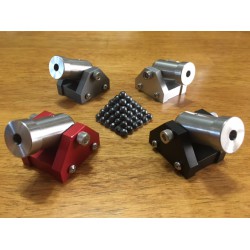


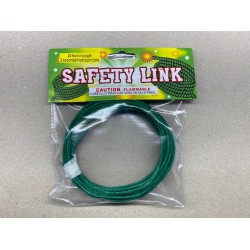
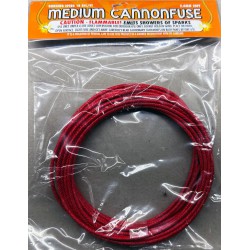

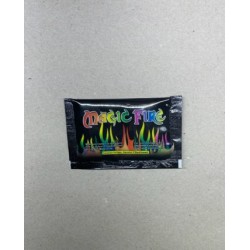
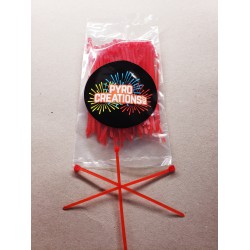
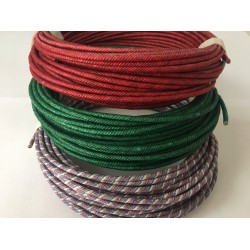
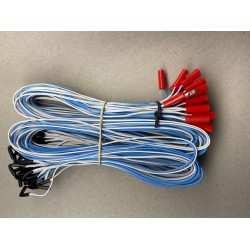
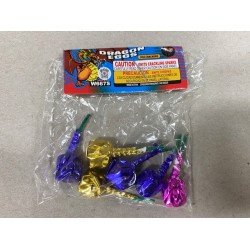

-250x250.jpg)
